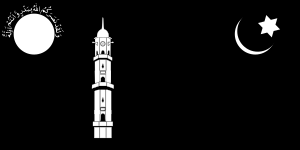Ahmadiyya
Ahmadiyya (Urdu: احمدیہ), fully known as Ahmadiyya Muslim Community is an Islamic movement founded in the 19th Century by Mirza Ghulam Ahmad who claimed to be the Mahdi and Promised Messiah. Ahmad wanted to restore Islam's original message. It was started before India was split into the modern day states of India, Pakistan and Bangladesh.
In 1914, the movement split into two different groups, over a question of who should become the next Caliph. Both groups still exist today.
Mirza Ghulam Ahmad claimed to have fulfilled the prophecies for the Mahdi. In addition to being a Mahdi, he was also called the Mujaddid (divine reformer) of the 14th Islamic century and the promised Messiah.[1][2][3][4][5]
Ahmadis consider themselves Muslims and claim to practice the Islam that was taught and practised by Muhammad and his followers. Mirza Ghulam Ahmad founded the movement in 1889 and named it the Ahmadiyya Muslim Jamaat (Community). His goal was to restore life into Islam.
The original Ahmadiyya movement split into two separate groups[6] after the death of Nooruddin, the first successor of Ghulam Ahmad.
The original Ahmadiyya movement split into two separate groups, after the death of Nooruddin, the first successor of Ghulam Ahmad. These movements are the Ahmadiyya Community and the smaller Lahore Ahmadiyya Movement for the Propagation of Islam (Ahmadiyya Anjuman Ishaat-i-Islam, AAIIL). The groups have different interpretations of Ahmad's teachings and claims. They also have different opinions on the status of Mirza Ghulam Ahmad and his successor, and how this person should be chosen.[6][7]
The larger faction of the Ahmadiyya Movement, known as the Ahmadiyya Community is active in 190 countries of the world. The International Headquarters of the Ahmadiyya Community is currently in London, England. The smaller faction, known as the Lahore Ahmadiyya Movement, is active in 17 countries of the world. They are most notable in Germany, Australia and Pakistan. The International Headquarters of the Lahore Ahmadiyya Movement is in the town of Lahore, Pakistan where the Lahore Movement started. Within Lahore, Pakistan, are the "Ahmadiyya Buildings Lahore" which act as the international administrative base for the Lahore Ahmadiyya Movement.
Controversial points include the Ahmadiyya view on the death and return of Jesus and their concept of Jihad. The Ahmadiyya community also has a different interpretation of verse Qur'an 33:40 of the Qur'an. This verse talks about Muhammad as the Seal of the Prophets. The members of the Lahore Ahmadiyya Movement are not subject to such criticism because they do not believe Mirza Ghulam Ahmad was a prophet. For this reason, they are more close to traditional mainstream Islam. Although mainstream Muslims consider them as heretics. Ahmadis (particularly the members of the International Ahmadiyya Muslim Community) argue that their beliefs are in accordance with Islam, and by using arguments from the Qur'an, Hadith and opinion of Islamic jurists and theologians, challenge the contention of the groups calling them non-Muslims.
Ahmadis have translated the Qur'an in all the main languages of the world. They broadcast globally on their 24-hour satellite television channels such as MTA 1, MTA 2, MTA 3, and a recently introduced MTA Africa. Ahmadis have provided teachers, doctors and humanitarian relief workers in many developing countries. The fourth Caliph, Hazrat Mirza Tahir Ahmad helped to promote homeopathy as a system of medicine by training practitioners through a regular TV class and establishing many free dispensaries around the world.
Criticism
The Ahmadiyyas are regarded as heretics by the orthodox Muslims because Mirza Ghulam Ahmad proclaimed himself the Mahdi of Islam as well as the second coming of Jesus. In addition, Ahmadis also differ on the interpretation of the Finality of Prophethood (Arabic: خاتم النبيين, khātaman nabiyyīn) where orthodox Muslim consider Muhammad to be the last Prophet, in contrast to the Ahmadiyya view, where Muhammad is considered as the final law-bearing prophet.[8][9]
Thus, the majority of Muslims do not refer to the Ahmadis by this name, but use the derogative term 'Qadianis' (referring to Qadian, India, the birthplace of Ahmad) and Mirzai (referring to Mirza Ahmad). These terms are used as Ahmadis are considered 'unworthy' of using the name Ahmad, an alternative name for Muhammad and therefore it is considered derogative, as it is to refer to Muslims as 'Muhammadans'.[10][11]
Ahmadiyya Media
The White Minaret and the Ahmadiyya flag in Qadian, India. For Ahmadi Muslims, the two symbolize the advent of the Mirza Ghulam Ahmad.
The Shahada, outside the Mahmood Mosque in Zurich, proclaiming the oneness of God.
Some of the many Quran translations by Ahmadi translators at the 2009 Frankfurt Book Fair
Baitur Rehman Mosque near Washington, D.C., is one of several mosques inaugurated by the fourth caliph
Baitul Futuh Mosque, one of the largest mosques in Europe. The Caliph's Friday Sermon is televised live throughout the world, via MTA TV
Pakistani campus of the Ahmadiyya University in Rabwah
The Ahmadiyya Flag and the flags of German states at the 2009 German Annual Convention
References
- ↑ “The Fourteenth-Century's Reformer / Mujaddid”, from the “Call of Islam” Archived 2017-05-18 at the Wayback Machine, by Maulana Muhammad Ali
- ↑ Claims of Hadhrat Ahmad, Chapter Two
- ↑ Reflection of all the Prophets
- ↑ Future of Revelation, Part 7
- ↑ The Removal of a Misunderstanding
- ↑ 6.0 6.1 ""The Split in the Ahmadiyya Movement" by Maulana Muhammad Ali". Archived from the original on 2021-04-12. Retrieved 2008-10-15.
- ↑ ""Refutation of Maulvi Muhammad Ali's Account of Ahmadiyya Dissensions"". Archived from the original on 2007-10-15. Retrieved 2008-10-15.
- ↑ Jones, Kenneth W. (1976). Arya Dharm: Hindu Consciousness in 19th-century Punjab. University of California Press. p. 148. ISBN 978-0-520-02920-0.
- ↑ The Illustrated Weekly of India, Volume 102, Issues 1-2.
- ↑ Fraser, Gordon (2008). Cosmic Anger: Abdus Salam - The First Muslim Nobel Scientist. Oxford University Press. p. 58. ISBN 978-0-19-157866-3.
- ↑ Jackson, Roy (2010). Mawlana Mawdudi and Political Islam: Authority and the Islamic state. Routledge. p. 50. ISBN 978-1-136-95035-3.

